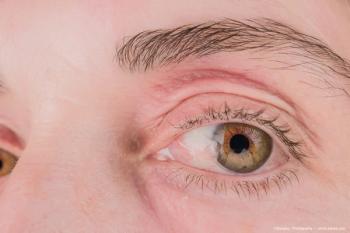
IOLs in cataract surgery – do the risks outweigh the benefits in infants?
This article presents recent epidemiological findings outlining the association between cataract surgery, potential visual acuity gains, glaucoma and the risk of undergoing additional general anaesthesia in under 2s. The authors of the original study concluded that use of IOLs in cataract surgery in young children should be critically reassessed, particularly in settings/communities where close, long-term follow-up is challenging.
Take-home message: This article presents recent epidemiological findings outlining the association between cataract surgery, potential visual acuity gains, glaucoma and the risk of undergoing additional general anaesthesia in under 2s. The authors of the original study concluded that use of IOLs in cataract surgery in young children should be critically reassessed, particularly in settings/communities where close, long-term follow-up is challenging.
By Faye Emery, OTE Editor, Reviewed by Dr Ameenat Lola Solebo and Prof. Jugnoo S. Rahi
Congenital and infantile
In most resource-rich countries, the introduction of whole population screening has been implemented to ensure earliest possible detection of cataract (e.g., the UK’s National Screening Committee’s Newborn and Infant Physical Examination programme).2
According to the early adopters of
- The potential for permanent in situ correction to offer better visual rehabilitation, which is thought to be especially important in children with unilateral cataract; in these children amblyopic deprivation is particularly strong due to rivalry from the unaffected eye.
- A reduction in the requirement for regular clinic visits to update contact lenses, and in the infection risk in developing countries, where access to clean water is limited.
- A possible reduction in the risk of postoperative glaucoma, a complication of cataract surgery in children.
In response to a lack of robust evidence on
IOLunder2 study details
The study, recently published in the British Journal of Ophthalmology, involved systematic data collection on children undergoing surgery in UK and Ireland between January 2009 and December 2010. Clinical data were collected at preoperative, peroperative, and 6-month and 12-month postoperative time points using study specific instruments developed through the BCCIG. Overall visual outcome was measured 1 year after surgery (best corrected acuity assessed using standard hospital-specific but harmonised approaches).3–5 The study authors described the 1-year time point as “an important milestone for families and clinicians, which is likely to correlate with longer-term outcome.”6,7
Standardised definitions were used for the two most significant adverse outcomes:
- ‘Secondary’ postoperative glaucoma [structural damage or neuropathy secondary to elevated intraocular pressure (IOP)]8
- Visual axis opacity (VAO) (proliferation of either inflammatory material or remnant lens fibres)
Multivariable regression analysis was used to control for potential confounders.
Overview of the results
Of 221 children, 56 out of 131 with bilateral and 48 out of 90 with unilateral cataract underwent primary IoL implantation. Evidence exists that suggests better early visual outcome, although not necessarily normal vision, with IoLs in bilateral cataract, though there remains some uncertainty about the effect size.
Investigators found that IOL implantation was independently associated with better visual outcome in bilateral disease (OR 4.6, 95% CI 1.6 to 13.1, p=0.004). However, in contrast to these findings, no similar results were observed for unilateral disease. In fact, IOL use increased the odds of reoperation (bilateral OR 5.5, p<0.01; unilateral OR 16.7, p<0.01), especially to correct VAO following primary IOL use. The risks of procedures requiring repeat general anaesthesia during such a critical period of childhood development cannot be overlooked.
A further noteworthy finding that came out of the study was that IOL implantation did not actually reduce the odds of postoperative glaucoma. Indeed, the authors found glaucoma to be a frequent complication within the first postoperative year, suggesting that IOL implantation is not protective, as had been previously postulated. While younger age at surgery is associated with better early visual outcome9 (supporting the value of screening) it is also the major risk factor for glaucoma.
Counteracting study bias
In observational studies, confounding factors (such as ocular size or coexistent ocular anomaly) are addressed through multivariable analysis. In addition to achieving a high degree of validity, the representative nature of this study cohort enables a high degree of generalisabilty for the study findings, and these early outcomes are expected to be predictive of longer-term outcomes.6,7
Obtaining reproducible, accurate quantitative visual acuity data from young children is undoubtedly difficult, particularly in the case of unilateral disease, where testing of the affected eye involves occlusion of the better seeing eye. Patient compliance was similar in the IOL and aphakia groups and further analysis of the possible determinants and impact of missing outcome data revealed that bias was likely to be minimal.
The lead author described the study as “…a unique, prospective, population-based cohort study of outcomes in children undergoing cataract surgery in the first 2 years of life, with high and unbiased ascertainment which was made possible thanks to the support of the BCCIG.”
Implications for clinical practice – unilateral cataract
Although there are no equivalent studies with which to directly compare IOLunder2, a North American group recently reported a randomised controlled trial of IoL implantation in infants aged 6 months or under with unilateral cataract, entitled ‘the Infant Aphakia Treatment Study’.6 The recommendation following the publication of this study was to ‘leave the eye aphakic’ in this subgroup of children. The IOLunder2 findings suggest that the use of IOLs should be reconsidered in all children under 2 years of age with unilateral congenital and infantile cataract.
Implications for clinical practice – bilateral cataract
Bilateral disease accounts for the majority of affected children, and for almost all cases of lens-associated childhood severe visual impairment / blindness.
Following on from their findings, the investigators suggest that the value of IOLs in bilateral disease (in terms of potentially better early visual outcome) should to be balanced against the risk of high reoperation rates which expose children to repeat general anaesthetic in a key period of neurodevelopment.
Children with secondary glaucoma following congenital/infantile cataract surgery usually face frequent long-term follow-up and multiple surgical interventions.14,20 Almost half of children affected by secondary glaucoma are severely visually impaired, and in some cases their vision is worse than that reported for unoperated cataract.10 As about 5% of children develop glaucoma in each subsequent year following primary surgery,11 it is possible that the majority of the IOLunder2 cohort could eventually be affected. Further research into the pathogenesis of this iatrogenic and potentially blinding outcome is therefore essential.
Future considerations
Findings from the IOLunder2 cohort study certainly highlight the challenges surrounding the timing of cataract surgery in young children. Deciding on an optimal time to operate requires prompt diagnosis, even where treatment may be deferred. It is unlikely that visual outcomes in resource-poor countries will improve without strategies for early detection. Longer term studies of the IOLunder2 cohort will further clarify the associations found, and the 5 year follow up study begins later this year.
These study findings should be reviewed in the context of the growing body of evidence relating to the possible association between multiple general anaesthetics in early childhood and long-term cognitive impairment.12 Investigators of the described study suggest that clinicians should now critically review practices. Furthermore, the study highlights the value of rigorous observational epidemiological research in the evaluation of surgical innovations for uncommon disorders, before they are widely adopted.
References
- L. Kong et al., J. AAPOS. 2012;16:501–507.
- NHS UK National Screening Committee. Newborn and infant physical examination. 2008. http://newbornphysical.screening.nhs.uk/evidence
- S.R. Salomao and D.F. Ventura. Invest. Ophthalmol. Vis. Sci. 1995;36:657–670.
- D.L Mayer DL et al.,Invest. Ophthalmol. Vis. Sci. 1995;36:671–685.
- T.O. Adoh and J.M. Woodhouse. Vision Res. 1994;34:555–560.
- S.R. Lambert et al., JAMA Ophthalmol. 2014;132:676–682.
- S.R. Lambert et al., Arch. Ophthalmol. 2010;128:810–818.
- M. Papadopoulos et al.,Invest. Ophthalmol. Vis. Sci. 2007;48:4100–4106.
- M. Chak et al.,Invest. Ophthalmol. Vis. Sci. 2006;47:4262–4269.
- M. Papadopoulos and P.T. Khaw. Eye. 2003;17:1–2.
- M. Chak and J.S. Rahi. Ophthalmology. 2008;115:1013–18.
- C. DiMaggio et al., Anesth. Analg. 2011;113:1143–1151.
Dr Ameenat Lola Solebo and Prof. Jugnoo S. Rahi
Dr Ameenat Lola Solebo is an NIHR Academic Clinical Lecturer and Prof. Jugnoo Rahi is a Professor of Ophthalmic Epidemiology/Honorary Consultant Ophthalmologist for the Population, Policy and Practice Programme, Institute of Child Health, University College London, London, UK.
The authors/reviewers declare no conflicts of interest relating to the content of this article.
Newsletter
Don’t miss out—get Ophthalmology Times updates on the latest clinical advancements and expert interviews, straight to your inbox.













































.png)


